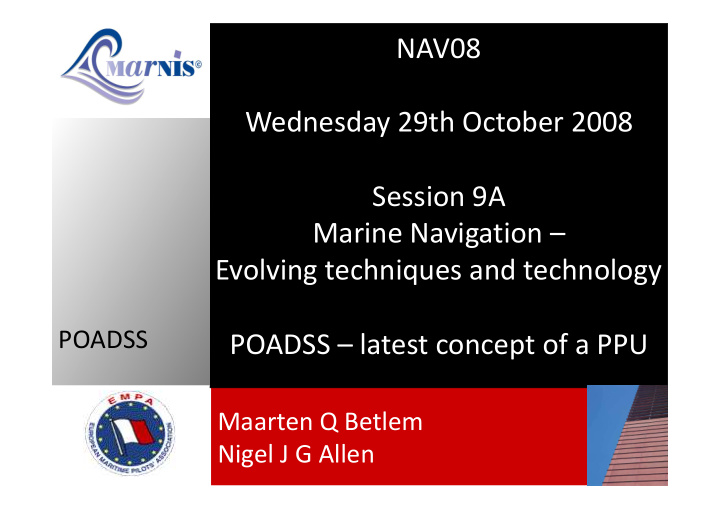



NAV08 Wednesday 29th October 2008 Session 9A Marine Navigation – Evolving techniques and technology POADSS POADSS – latest concept of a PPU Maarten Q Betlem Nigel J G Allen
A new concept of a Portable Pilot Unit (PPU) P ortable O perational A pproach and Portable Operational Approach and D ocking S upport S ystem Decision Support System POADSS (POADSS)
Stages of the project 1. State of the Art PPU’s 2. Definition of User Requirements 3. Development of a POADSS 4. Testing 5. End Result/Report POADSS MarNIS – Sixth Framework Programme
Evolution of PPU’s Current PPU’s– Laptop, Chart Software + GPS = real time position! + DGPS = better accuracy + RTK = centimetric accuracy ( 2D ‐ horizontally) + AIS = decision support MarNIS PPU’s ‐ Vertical position ‐ (3D) Integrate an IMU – dynamic motions ‐ roll, pitch, heave Broadband – real time info ‐ tide, weather, traffic, WMS High density bathymetric data – up to date detailed info Dynamic Under Keel Clearance software (DUKC) POADSS = POADSS
In the next decade an increase in traffic is expected in European Ports, which will result in: • complex traffic patterns within ports, fairways and their approaches • ever larger ships using the same infrastructure These expectations require the latest information technology aboard and ashore to improve: • the overall safety and efficiency of all vessel movements • better decision support (both ways between the ship and shore) POADSS
Objectives • Make better use of the fairway • Engage the Bridge team with the Dynamic Passage Plan, as well as the VTM • As well as a Dynamic Passage Plan, also with real time data. The MarNIS project has addressed these challenges POADSS through the development of the POADSS.
• Integration of an Inertial Measurement Unit (IMU) with Global Navigation Satellite Systems (GNSS) to determine all dynamic movement of the vessel • Wireless broadband to exchange information in real time (WMS) • Presentation of dynamic high density bathymetric data displayed on an electronic chart (dynamic safety contour) • Dynamic Under Keel Clearance (DUKC) POADSS (actual and predicted UKC) New Applications bbb
Architecture of POADSS system • onboard unit – onboard data collection and the User Interface functionalities for the pilot, consisting of : • instrument unit (IU) • user interface unit (UIU) (laptop) • communication network • wireless networks • UHF radio band (RTK correction signal) • HSDPA (commercial broadband ) • WiFi (between laptop and Instrument Unit) • shore server – provides the centralised data base and information channel management functions POADSS • shore front‐end – UIU functionalities for the management of the system acting as client of the server
POADSS onboard unit • instrument unit (IU) integrated GPS receiver/ inertial measurement unit (Coda Octopus F185+ with NovAtel antennae) RTK receiver, AIS receiver Motherboard, battery pack • user interface unit (UIU) ‐ (Laptop) compaq 2710 P windows XP dedicated POADSS software • connection between IU and the UIU by LAN (WiFi) POADSS • onboard unit has battery capacity for 6 hours and a connecton for an external power supply
Accuracy position: 50 cm horizontal stand alone (EGNOS) 2 cm horizontal (RTK) 5 cm vertical (RTK) speed: 0.03 cm/s roll/pitch: < 0.025 deg Heading: 0.025 deg (antenna distance 4m apart) POADSS heave: < 5 cm
POADSS software modes 1. information mode 2. planning mode 3. navigation mode POADSS 4. docking mode
Web Map Services (WMS) 1. Tactical Traffic Image from VTS (AIS, Pseudo AIS/ Radar tracks, Radar video) 2. Wind ‐ direction and speed 3. Current ‐ direction and speed 4. Wave ‐ significant height, direction and period 5. Meteorological/hydrographical warnings 6. Berth/Terminal information 7. Temporary/restricted/closed areas etc. WMS New Applications
Selected Standards WMS – Web Map Service • Widely used in the world of GIS – Geographical Information Systems • Established by OGC – Open Geospatial Consortium • Consists of 3 requests/responses: GetCapabilities, GetMap and GetFeatureInfo • Based on HTTP, i.e. the World Wide Web protocol WMS Sharing VTS Information
High Density Charts POADSS Dynamic Charts with Tide input
DUKC DUKC ‐ Predicted
DUKC ‐ Actual DUKC
Software easy to use • In Europe, most PPU’s have ship ‘type tested’ software, slightly modified for a Pilot to use • POADSS has Port specific software • Lisbon Pilots have determined the POADSS POADSS laptop presentation, specific for their needs
POADSS Training Proposed PPU Training Standards ECDIS IMO Model Course 1.27 AIS IMO Model Course 1.34 Manufacturers Type specific training Familiarization trips accompanying another Pilot Assessment Meets IMO A960 requirements (23) 6.2 POADSS Apart from ‘assessment’ – Lisbon Pilots received the above
‘Lisbon Live’ via Port of Lisbon VPN to POADSS Server in VTS WMS POADSS Broadband WMS
Image of Planning Mode POADSS Ship data settings
Image of Planning Mode POADSS Route selection/edit
Image of Information Mode WMS POADSS Wind and Temperature
Image of Information Mode WMS POADSS Special Areas ‐ regatta
Image of Information Mode WMS POADSS Raw Radar
Image of Navigation Mode POADSS Routes
Image of Navigation Mode POADSS DUKC Panel
Image of Docking Mode POADSS Berthing Line/Distance off Prediction
Radar video, radar/AIS tracks AIS WMS Sharing VTS Information
Attention Areas / Points AIS WMS Sharing VTS Information
Proposed Approach Route AIS WMS Sharing VTS Information
Terminal Information AIS WMS Sharing VTS Information
Weather information Meteo/Hydro Forecasts AIS WMS Sharing VTS Information
Wave Response DUKC Measured vs Modelled at Lisbon
Squat SQUAT DUKC Measured vs Modelled at Lisbon
+ sounded depth Underkeel Clearance = ‐ survey tolerance ‐ siltation
Underkeel Clearance = + sounded depth ‐ survey tolerance ‐ siltation + astronomical tide + tidal residual Tidal Datum
Underkeel Clearance = + sounded depth ‐ survey tolerance ‐ siltation + astronomical tide + tidal residual
+ sounded depth Underkeel Clearance = ‐ survey tolerance ‐ siltation + astronomical tide + tidal residual ‐ draft
Recommend
More recommend